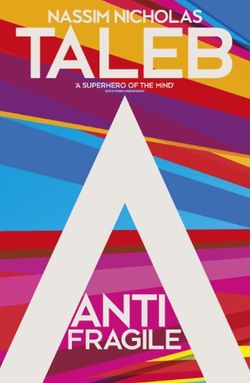- Tags:: 📚Books, Uncertainty
- Author:: Nassim Nicholas Taleb
- Liked:: 6
- Link:: Antifragile (book) - Wikipedia
- Source date:: 2012-11-27
- Finished date:: 2019-01-01
- Cover::

Technology is the result of antifragility, exploited by risk-takers in the form of tinkering and trial and error, with nerd-driven design confined to the backstage. Engineers and tinkerers develop things while history books are written by academics.
Infoxication and RRSS
The more frequently you look at data, the more noise you are disproportionally likely to get (rather than the valuable part, called the signal); hence the higher the noise-to-signal ratio. And there is a confusion which is not psychological at all, but inherent in the data itself. Say you look at information on a yearly basis, for stock prices, or the fertilizer sales of your father-in-law’s factory, or inflation numbers in Vladivostok. Assume further that for what you are observing, at a yearly frequency, the ratio of signal to noise is about one to one (half noise, half signal)—this means that about half the changes are real improvements or degradations, the other half come from randomness. This ratio is what you get from yearly observations. But** if you look at the very same data on a daily basis, the composition would change to 95 percent noise, 5 percent signa**l. And if you observe data on an hourly basis, as people immersed in the news and market price variations do, the split becomes 99.5 percent noise to 0.5 percent signal. That is two hundred times more noise than signal—which is why anyone who listens to news (except when very, very significant events take place) is one step below sucker. Consider the iatrogenics of newspapers. They need to fill their pages every day with a set of news items—particularly those news items also dealt with by other newspapers. But to do things right, they ought to learn to keep silent in the absence of news of significance. Newspapers should be of two-line length on some days, two hundred pages on others—in proportion with the intensity of the signal. But of course they want to make money and need to sell us junk food. And junk food is iatrogenic. There is a biological dimension to this story. I have been repeating that in a natural environment, a stressor is information. Too much information would thus be too much stress, exceeding the threshold of antifragility (…) Now let’s add the psychological to this: we are not made to understand the point, so we overreact emotionally to noise. The best solution is to only look at very large changes in data or conditions, never at small ones. Just as we are not likely to mistake a bear for a stone (but likely to mistake a stone for a bear), it is almost impossible for someone rational, with a clear, uninfected mind, someone who is not drowning in data, to mistake a vital signal, one that matters for his survival, for noise—unless he is overanxious, oversensitive, and neurotic, hence distracted and confused by other messages.
Via negativa
… in practice it is the negative that’s used by the pros, those selected by evolution: chess grandmasters usually win by not losing; people become rich by not going bust (particularly when other do)… (p. 302)
The greatest—and most robust—contribution to knowledge consists in removing what we think is wrong—substractive epistemology. (p. 303)
…we know a lot more what is wrong than what is right (…) what we know today might turn out to be wrong but what we know to be wrong cannot turn out to be right, at least not easily. (p. 303)
On managing teams too:
In political systems, a good mechanism is one that helps remove the bad guy; it’s not about what to do or who to put in. For the bad guy can cause more harm than the collective actions of good ones. (p. 304)